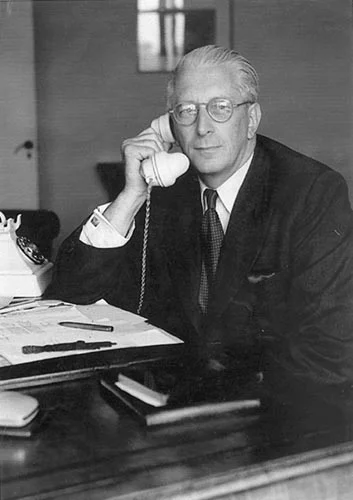Sidney Cotton today is recognised as the father of photographic reconnaissance. He flew a Lockheed 12A Junior Electra with cameras concealed in the cabin floor.
In the late 1930s, Cotton ran a photographic business and lived in London. He was a skilled pilot who had flown combat missions with the Royal Naval Air Service in World War I.
Between the wars, Cotton ran an aerial seal-spotting operation in Newfoundland and developed a colour film process.
Cotton counted among his close friends Winston Churchill, James Bond creator Ian Fleming and Kodak boss George Eastman. He was on close terms with top-ranking Nazis.
As Cotton had legitimate reasons for going to Germany, the Air Intelligence branch of the Secret Intelligence Service (MI6) asked if he would be prepared to take pictures from the air.
MI6 bought him the Lockheed and had the aircraft modified to hide cameras in the floor. They were F24 cameras; one faced down and the other two were at a 45-degree angle.
The cabin was heated and warm air flowed over the camera lenses so they did not freeze. At 20,000ft the cameras could cover an area 16km wide.
The hole in the floor was covered with a sliding panel flush with the aircrafts skin. A car windscreen wiper motor operated the panel and a button under the pilots seat activated the cameras.
The aircraft also carried in the wings small Leica Reporter cameras with 250 exposures. Cotton had the Lockheed painted pale blue so it was all but invisible at altitude.
His secretary, always accompanied him to reload the cameras and take pictures using hand-held equipment. Cotton never flew in a straight line but a flight path that meandered over important installations such as the Luftwaffe test centre.
Cottons cameras took photographs of everything the Germans wished to hide, munitions factories, airfields, troop concentrations and anti-aircraft batteries.
On one trip to Berlin, Cotton photographed the naval base at Wilhelmshaven and even took pictures of Hitlers personal yacht.
He posed as a businessman, an archaeologist or a film producer looking for locations for a movie. His most audacious act was to take Luftwaffe officer Albert Kesselring, who became one of Hitlers outstanding commanders on a flight while taking spy photographs.
Cotton offered to take Kesselring on a flight along the Rhine, saying he had a maiden aunt who lived there.
After the Lockheed was airborne and Kesselring was at the controls, Cotton reached under the seat and switched on the hidden cameras, photographing fortifications and airfields. Kesselring was unaware the photographs were being taken, nor that there was no maiden aunt.
A week before war started, Cotton flew to Berlin on his own initiative to collect Luftwaffe chief Hermann Goering and fly him to England for talks with the British government.
However, Hitler refused to allow Goering to make the trip. Cotton was told to return to England and not to divert from his flight plan or he would be shot down. Cotton claimed the Lockheed was the last civilian aircraft to leave Berlin before WWII.
Cottons work with MI6 led to him being given his own clandestine photographic unit. He was appointed a squadron leader and empowered to hire civilians or military members.
The unit quickly became known as Cottons Club or, more unkindly, Cottons Crooks. Cotton even had a special badge struck bearing the initials CC-11 that signified the 11th commandment, Thou shalt not be found out.
The unit was initially equipped with modified Bristol Blenheims, but they had a mediocre speed and ceiling and were unsuited to aerial reconnaissance.
Cotton wheedled two Supermarine Spitfires out of Fighter Command and had them fitted with cameras instead of guns.
The Spitfires ranged over Germany flying fast and high. The Photographic Development Unit he commanded later became the Photographic Reconnaissance Unit, which by wars end employed more than 5000 pilots, photographers and photographic interpreters.
We were Sid Cottons air force. An elite secret unit,Jack Eggleston, a former RAF photographer, said.
"The thing I liked about Sid Cotton was that I didnt have to salute him." According to Group Captain Frederick Winterbotham, the spymaster who hired Cotton and helped him pioneer new techniques in aerial photography, there were three things in Cottons life: flying, money and women.
He was, said others, a maverick and a buccaneer who was unsuitable for employment in a uniformed service.
Before France fell, Cotton was ordered to fly the Lockheed to Paris to evacuate British agents and secret papers. When he arrived he found many Frenchmen were trying to escape to England. Among them was Marcel Boussac, the boss of the Christian Dior garment and perfume empire.
Boussac was carrying a briefcase full of thousand franc notes, so Cotton agreed to fly him to England at a price. This was too much for the Air Ministry and Cotton was relieved of his command.
He received a letter from the Air Ministry thanking him for the great gifts of imagination and inventive thought which he had brought to bear on the development of aerial photography. He was also awarded the Order of the British Empire.
After WWII, Cotton dabbled in oil exploration, civil engineering and ran guns into the Indian state of Hyderabad using second-hand Lancasters.
The latter venture was said to have made him a millionaire but he died in England in 1969 penniless. The only monument to the amazing Cotton is a small metal plaque on his grave at Tallegalla cemetery near Brisbane.












